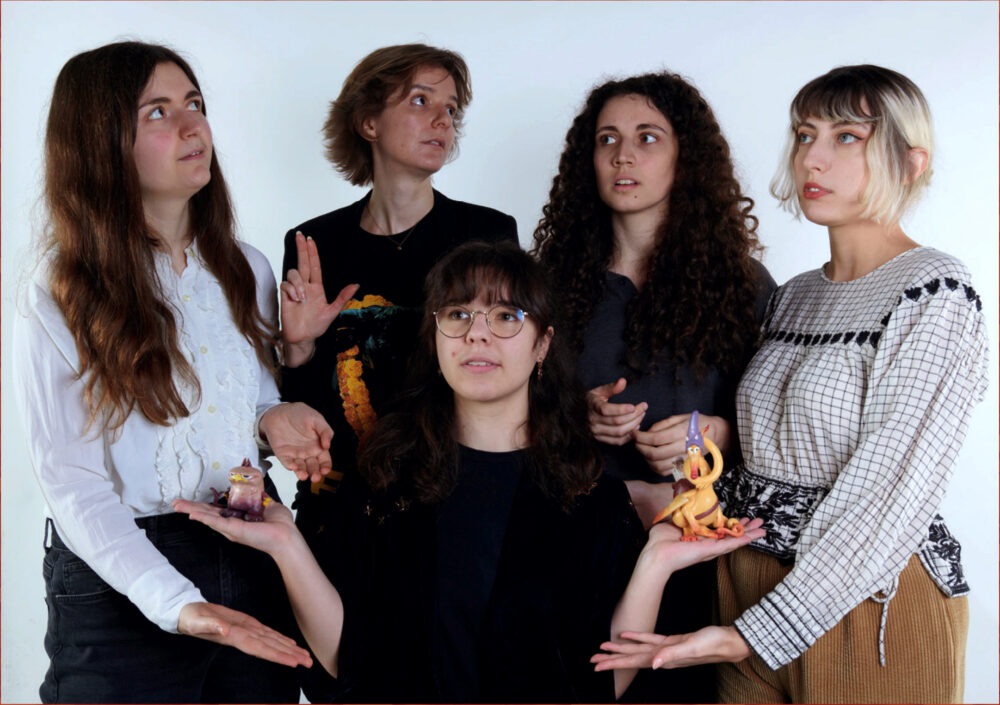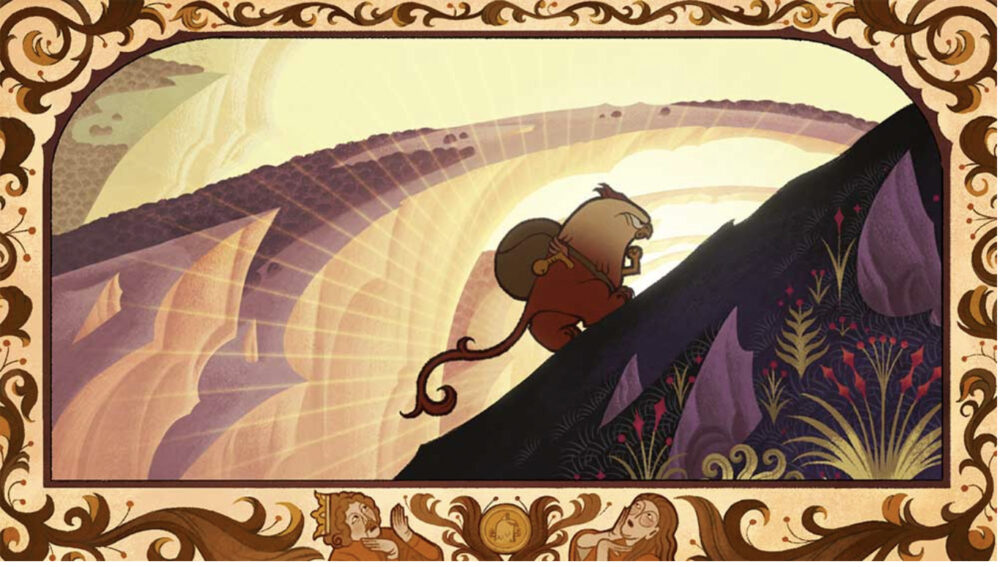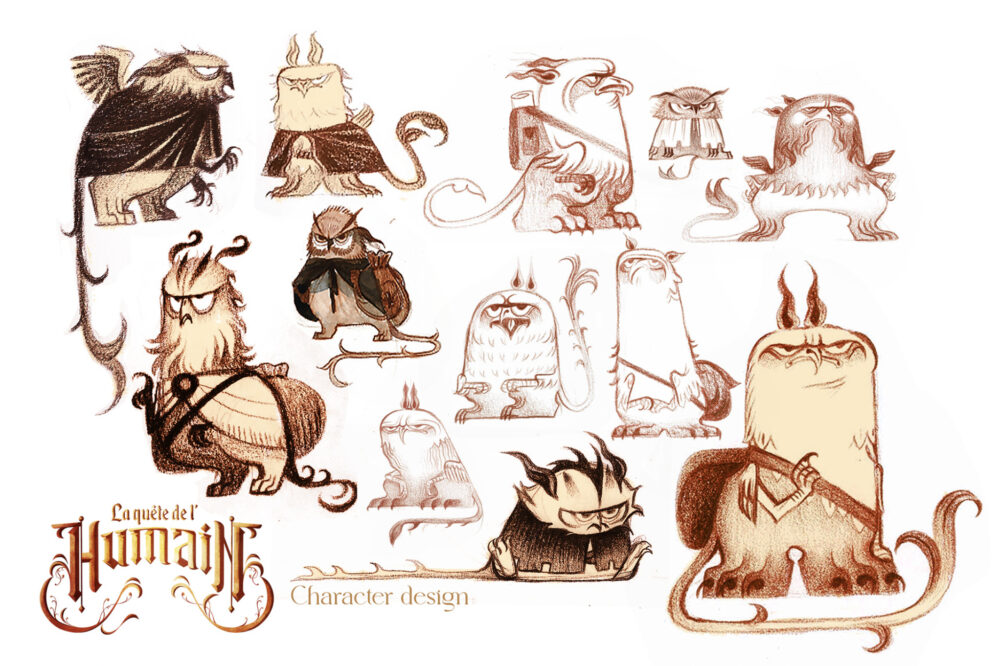Paris-based school Gobelins often ranks among the top animation programs worldwide. The graduation films made by the students often dazzle the audiences at Annecy and other film festivals globally. This year, La Quête de L’Humain (The Search for the Human), one of the recent shorts made by the students at the school, won the Grand Prize at the Rhode Island Intl. Film Festival and has qualified to be considered for the Academy Awards. The team behind the short (Mélina Ienco, Lucie Juric, Caroline Leibel, Faustine Merle, Claire Pellet) who graduated in 2022, answered a few of our questions about their short, which centers on an adventurous griffin who sets out to find out if mythical creatures known as humans actually exist or not.

Animag: Can you tell us a bit about the origins and inspirations for your short?
Mélina Ienco, Lucie Juric, Caroline Leibel, Faustine Merle, Claire Pellet: From the start we agreed that we wanted to make a funny film. Many of the graduation films that had been made so far at our school had dark and dramatic atmospheres and we wanted to do something different. Writing and directing a comedy with others was also a challenge that we wanted to take on. We also wanted to tell a real story and not just do a stylistic exercise: the idea was for our film to be accessible to the general public and not just aimed at people in the animation world.
We wanted to create a fantasy world inhabited by monsters. We quickly moved towards the creatures of medieval European illuminations, which are not often represented in cinema. Once we had our pitch with a monster looking for a human, we decided that we would like our protagonist to have a personality similar to that of Dwight, the character from The Office, which makes us laugh a lot. From there, we watched many documentaries about cryptozoologists and conspiracy theorists. We can see there people who are very intense in their convictions, like this guy named Mark Sargent, and that really motivated us to continue in this direction.
Can you describe your visual style?
Our visual style is based on illuminations, very straightforward in the way they represent things, to which we have added more fantasy and sometimes kitsch colors. It’s very illustrative, with somewhat cartoonish characters. The main difficulty was to succeed in keeping these very graphic aspects while finding a way to incorporate a solid and volume animation to it.

How long did it take to make and how many people worked on it?
We spent a year on the film. There were five of us directing and producing the film (from writing the script to compositing). We were also helped by nine people from outside the class, some of them being interns. Finally, there was a composer/musician, two sound designers, a foley artist, and our three voice actors.
Which animation tools were used?
We mainly worked in digital format. A small part of the film was mostly done in the traditional way, with backgrounds made on black paper, but even there the animation was done on computer with TVpaint with special brushes.
What were the most helpful advice you received from your teachers at Gobelins?
One of our teachers told us that for films like ours, everything is based on the protagonist. We therefore had to work a lot on his design and succeed in making him a charismatic and endearing character at first glance.
We also had difficulty agreeing on a definitive rendering style. He advised us to work on style frames like we would do with illustrations, and that helped us a lot.
What do you love about the animation program and what do you think sets this school apart from other similar animation programs?
We had great modules and speakers. Gobelins works like an animation studio: We have exercises with deliveries on a given date, and we are free to work as we wish as long as the final product is done by the deadline. We had also worked as a group on short films before and learned how to work together, and who we could form a good team with. It helped us a lot to organize ourselves and more generally to save time afterwards.
We also had great opportunities, for example the possibility of carrying out exchanges with schools abroad, and we were able to make an opening short for the Annecy festival.
Who are some of your big animation influences?
The trailer for the film Sirocco was a bit like our first inspiration. It allowed us to agree on the idea of a conceptual world populated by monsters, with its own, very graphic identity. In addition, the animation was very “volume keeping” with rather cartoonish monster designs, it showed us that what we wanted to do was possible.
There is also Felix Colgrave, who makes quite conceptual and graphic animations based on crazy monsters.
What are your plans for the future?
We would very much like to succeed in transforming the film into a series, which would take up our story in a much richer way and with lots of additional adventures. It would also allow us to deepen the universe of the film, and to fit in a certain number of jokes and characters that we did not put in the short film, due to lack of screen time. We are currently working on a file to send to studios to be able to find financing.
What kind of advice would you give other animation hopefuls who would like to make their own short in the future?
You should not hesitate to spend a lot of time writing the film to ensure that you tell a real story, and not be afraid of something simple. Having a stable and clear basis allowed us to move forward calmly in the rest of the production. We think it is important to put the film before everything else and especially before everyone’s egos: our goal was to make the best film we could do, and not to individually demonstrate our skills. Don’t hesitate to ask for lots of feedback from those around you and from each other, and trust your teammates.
Don’t be afraid to experiment with styles and look for something different that you like, keeping in mind that the choices should always serve the film.
Last but not least, have fun and enjoy yourself. Take breaks, too, the coffee break is very important. Making a film is a grueling marathon, so you might as well do it while laughing and having a good time with your friends.
You can watch the short below:
For more info, visit gobelins-school.com/gallery/la-quete-de-lhumain






 Win a Funko X Lilo & Stitch Prize Pack!
Win a Funko X Lilo & Stitch Prize Pack!

